My name is Bill Fettes. I am a sixty-seven years plus retired police officer from South Australia. I joined the police at the ripe old age of 47, and retired at 67 and a bit at the end of 2017. Most of those twenty years were spent on the cutting edge, and the rest in Intelligence and Undercover jobs. I worked the entertainment districts in our capital city, Adelaide until after my 65th birthday, when the police union decided I was too old to insure.
I commenced my study of Asian combatives in 1968 with aikido & Shindo Muso-ryu jodo (Japanese medium length staff) in 1980, simplified and Yang-style taijiquan (Taichi) in 1981, Chen-style taijiquan, xingyiquan, baguazhang and Shaolinquan in 1985. The last of my current training regimes was Toda-ha Buko-ryu naginatajutsu, which I commenced in 1989.
Unlike the perception that many uninformed may hold, I have found that classical martial arts technique, particularly those from the so-called ‘internal’ martial arts, have been invaluable in my career as a police officer. I generally used aikido, taijiquan and the occasional animal technique from xingyi. There were a number of reasons for that:
- Contrary to the fantasies of the public, where ‘proper’ violence, enacted for the right reasons, is always as efficient and un-troubling as that in an old Western movie, violence is always ugly. The techniques of the internal martial arts are powerful, but often do not look like much. In particular, these arts frequently use palm strikes which do not appear as brutal as a blow with a clenched fist. Public perception is truly relevant to officer safety, and these techniques do not appear to be as grossly violent as a ‘ground and pound,’ for example, even though they are equally effective.
- They are far less easy for an assailant to see, yet they can inflict great pain and thereby induce compliance by eliminating the opponent’s will to fight.
- They can also be used to unbalance and/or throw those who are too far gone on drugs to feel pain.
- A final benefit I have found in the ‘internal’ arts is their first rule of thumb – avoid the attack. It is much easier to dissect some idiot if he misses with his first shot, and then plays into your hands with his attempts at recovery. Or slip some hulk altogether and take him down from behind—much easier to cuff him too.
In terms of this account, however, the internal arts are so inter-related that it is difficult, at times, to name exactly what technique I used. I can’t say for sure that my palm strike is louxi aubu (Yang style), xieying aubu (Chen style), piquan (xingyiquan) or shomen-ate (from Tomiki aikido). This is not a bad thing: if I don’t know what it is, it’s unlikely anyone else does.
My other main rule was to never deliberately go to the ground; too many of my mates finished up in hospital beds with concussions to make it anything but an ‘oops’ technique for me.
Let’s explore some of the odd and mundane situations that have been thrust upon me. (NOTE: click images for larger view).
Sumiotoshi AKA Haidizhen
Early winter’s morning about 0200 or 0300. My partner and I see a car that we had chased the night before—and lost. The guy driving the previous night was a well-known breaker, and he was driving whilst disqualified. The courts would likely let him off again, but that really wasn’t our concern. We followed him through the back streets with the dome lights flashing but, although he wasn’t speeding, he wasn’t stopping either. Finally he decided to ditch the car and drove it into a driveway—where it commenced to roll away—and he made a bolt for a grass park between two rows of houses. My partner, who was in the passenger seat, took off after the passenger whilst we were still in motion, and I took off after the driver. He was in worse shape than I was—which took some seriously bad lifestyle choices as I was into my fifties by then—so I started to reel him in.
As I said, it was early winter and the grass was slippery. As I got closer, my feet went from under me and I finished unceremoniously on my rear end. Seeing this, the miscreant turned around and ran straight back at me. As I started to get one foot under me, he let go with a straight right at my head. Fortunately I had enough purchase with my supporting foot to move my body out of the way, and as his fist sailed past my face, I grabbed his right wrist in both hands and let him fly past without attempting to halt his progress. As he realised he had missed, he started trying to recover his momentum by pulling up and back with his arm, and as he did so, I pushed both my hands in the direction he was now trying to go. In essence, I let him ‘control’ me as he pulled up and back; and then I suddenly whipped his arm down to his rear and back towards me in a circular motion. The result was it his feet suddenly left the ground and flailed through the air, landing him flat on his back. Whilst the stuffing was still knocked out of him, I rolled him over and cuffed him. Game over.
I used the same technique on another occasion. In a side street off the main entertainment drag we spotted a big bloke, who was holding his sister against a post with one hand and punching her with the other, when my partner and I rocked up. Our appearance didn’t faze him at all, and he continued on his merry way. I intercepted one punch and, as he tried to drag his fist clear of my grip, I simply moved with his violent pull to the rear, swept his leg, pushed down on his wrist and elbow and planted him on the concrete.
This technique could be summed up as either sumiotoshi from Tomiki aikido or haidizhen from taijiquan (all styles). It involves the avoidance of an attack, grasping the wrist and/or elbow and when the opponent pulls back to try to get away, taking him down to the corner behind and slightly to the side of his direction of pull. He is usually putting so much effort into pulling away that he goes down pretty quickly. The leg sweep was my own addition from baguazhang.
Udegaeshi AKA Daojuangong
Outside the local thug pub at closing time. All kinds of drunken, drugged patrons were milling around waiting for a ‘leader’ to emerge and start something. Lots of followers, but no leaders until our friendly local giant returned from breaking trees, urinating on them and kicking anyone who tried to get in his way. One of our lads from another team went to remonstrate with him, and I approached from the front. As our man went to reach for him, the large fellow launched a big right hook. I happened to be standing close enough to grab it on the way to my friend’s face. Our miscreant took one look at the poor old man holding his right arm and made to draw back for another shot. As he did, I let go with my left hand and folded it over his forearm and back under my own right wrist—much like a figure four—locking his rather large forearm between mine. As he continued to try to drag his arm out and back towards his shoulder, I let him pull away—he was far too strong for me—and quickly placed his trapped hand on his own right shoulder. As I placed my right foot behind his right heel, I continued to extend his trapped hand over his shoulder and down his back, at the same time pulling my heel towards me and sweeping his heel from under him. Not being accustomed to breakfalling, he hit his head on the gutter. However, such was his level of drug usage and intoxication that he didn’t even blink. He tried several times to get up, but I simply leaned my body weight against his arm, which I still had locked up, until other officers arrived. He was still spitting and swearing in the back of the cage vehicle.
This is what we call in Tomiki aikido, udegaeshi (arm return), and several Chinese teachers have shown it to me as a variation of daojuangong which, instead of a retreating palm strike, uses this folding of the opponent’s arm back upon itself. It resembles a figure four arm lock, but relies on the power of the opponent pulling back strongly to go with his power and over-extend him.
Tenkai Kotehineri
I was working the soccer venue (Hindmarsh stadium) for the 2000 Olympic tournament, and we had the game between Japan and Korea. Pretty interesting game too, but halfway through, we had a Japanese tourist who decided his ticket entitled him to sit in the aisle and block traffic in-and-out of the seats. We were tasked to remove him. Firstly, I asked the gent politely to remove himself, but he pretended not to understand English. I asked him again in Japanese—I’d spent 8 years in Japan and was still pretty much fluent. I cajoled him, embarrassed him and even told him he would waste his ticket money because he would be leaving soon. All to no avail. He wasn’t going anywhere, he told me in both English and Japanese. I decided it was time to go, and informed command what I was about to do.
Apparently that wasn’t what I was going to do as there were those higher up the food chain who thought it might be politically damaging; we had to get a real Japanese speaking interpreter to speak to him. This went on for some time until they realized that the game would be over before that happened. I finally got the go ahead to remove him. He had his hands on the steps on either side of him, so I reached between his body and his hand (I am pretty sure that it was his right and my left as this is a better technique for me on my left). I pulled his forearm up slightly and inserted my fingers into the palm of his hand with my thumb on the back. This meant the palm of my hand was on his hand blade or the edge of his hand. Then I simply twisted in an anti clockwise direction (his right, my left remember) and he jumped up like he had been shot. Keeping the pressure on, I simply walked him up the aisle and out of the stadium. He whined like a 5 year old all the way out: “Itai, Itai!” (“It hurts, it hurts!”).
The boss, who hadn’t been convinced I could converse with this fellow later came over extolling my efforts, saying that he had been watching what millions on television were seeing and couldn’t see what I had done. Ah, sometimes we at the coalface do know what we are doing!
As a technique, this is called tenkai kotehineri (body turning wrist twist) where the whole body rotates under the armpit and puts full body pressure on the wrist joint. As is often the case in Japan and Victoria (Australia) where one of my first teachers taught the police, it is used as a come-along hold. It is excruciating (if you haven’t strengthened your wrists), and I often used a version to pin miscreants to the ground whilst cuffing them. For example, if I were holding the right wrist of an offender lying face down. I would place my left hand under his right and place the fingers in his palm and then exert a twisting pressure on the hand. Most times they assist me in putting the cuffs on to get away from the pain.
Shé AKA Udehineri AKA Daojuangong
Several of the animals of xingyiquan (which is basically a striking art) have the capability of being locks or throws. One such, is shé (snake form). As I was taught it, the snake has two types: the strike (as in a viper or cobra) and the constrictor. At work I have found the coiling movements of the snake to be especially useful: unobtrusive, and needless to say, effective. One night we had rocked up to a disturbance not far from our Detox center where we shipped our most incapable drunks. There was government housing just across the road and one of the regular inhabitants had done enough to get himself arrested. I was there as a back-up to the attending patrol, and another officer had hold of the miscreant’s right arm. I grasped his left wrist with both hands, thinking to secure him for conveyance. For some reason, the other officer let go, and the bad guy turned to swing his now free right hand at me. I pivoted with the movement (i.e. further behind his left arm which I still held) and slipped my right arm under his left forearm, up and over the shoulder pressing down on the back of his shoulder and triceps forcing him to the ground. Easy to cuff from this position, too! This was used from a position where I had grasped the offender, however it can also be used against a strike or kick as it is preceded by a fist or ridge hand to the groin, which forces the other fellow to pull back his lower body thus making it easier to lock the outstretched arm.
Although my first thought was classic python, you could also make a case for udehineri from Tomiki Aikido which involves folding the elbow with left hand over the elbow placing that hand on your own right and either throwing or locking using your body weight on the joint. I was also taught a version of taijichuan’s daojuangong using this method, although it’s not the most well know usage of the technique.
Yīng-Xióng AKA Ji AKA Hiki-taoshi/oshi taoshi (depending on direction)
Attending a domestic on the street in one of the less salubrious neighborhoods in our fine metropolis. A male had his ‘girlfriend’ in a phone box, and according to witnesses, had belted her about fifty times already. We rocked up, and he was in my partner’s face straight away. This made me unhappy as she was a probationary constable with only a few months under her belt out of the Academy. She didn’t need this, and neither did the mother of his child—or their baby herself, whom he was using as a shield to keep us away. I took him by the left arm—using the SAPOL methodology for one hand on the elbow and the other on the wrist—and he eventually relinquished the baby to my partner. Straight away, he turned towards me and swung a big right cross at my head. As he did, I placed my right foot behind his left, and my right hand on his left elbow and pivoted to my left using the power of his swing to continue to take him in a circle towards the ground. He was still continuing to struggle, so a strategically placed knee on the third vertebra down his spine kept him somewhat submissive until I was able to cuff him. I was shown a photo later of his face after it hit the bitumen—small wonder that he wanted to place a Police complaint—which is something you do when you lose a fight you thought you should win or if you get a fine and don’t want to pay it. One of the other officers interviewed him—because he didn’t want to talk to me for some strange reason—but he tore up the complaint when he discovered that I was nearly three times his age, a little older than the duty judge that day.
I have used this technique in different forms many times over the years—against punches and from the control position—because it’s so effective. I felt bad about dropping someone one day with this until I found out later that he had an arrest warrant for murdering his 18-month-old baby. In this case, you could make a case for hikitaoshi from Tomiki aikido, yīng–xióng (bear-eagle) from xingyiquan or ji (peng, liu, ji, an) from taijiquan.
Lóng AKA Shoushi AKA Gedan-ate
In the wee small hours of a long night of revelry, we had a crime scene outside one of our favourite fight venues (otherwise known as nightclubs). A crime scene is generally surrounded by tape, and passersby are encouraged to keep out. For the most part they comply, sometimes after explanations. Then there are others who insist on free rights of passage—even through your crime scene. On this occasion, a large, drunken male had received my mandatory 2 warnings plus four more from other team members. He wasn’t taking my hints that the open door of the Police car was for him, and swung a big roundhouse right at my temple. I dropped straight under it, sweeping his arm down towards his knee. With my right shoulder supporting and both arms wrapped around his knee, I simply leaned on his knee with my body weight and his knee buckled. He cracked his head on the double-glazed window of the druggie chemist next to the nightclub and went to sleep for a short while. On CCTV it just looked like I had stumbled into him.
Jujutsuka could make a good case for this being a ‘shoot,’ but never having done jujutsu, it could be anything from the closing movement (shoushi) of Yang Taiji, to lóng (dragon) from xingyiquan to gedan-ate from Tomiki aikido. All involve taking the attacking arm out of play whilst dropping to waist level or below to take out the legs. Whichever one you care to name it, works a treat.
Danbian AKA Gyakugammae-ate AKA Yima fenzhong AKA Hangmen guanr AKA Irimi AKA Tuó AKA ‘a lot of techniques in Baguazhang’
One sunny Sunday afternoon, my partner (a couple of weeks out of the Academy) and I had arrested a male who was living in a tent in a small park in the centre of the city. He had roped off his tent and declared it a separate country, proclaiming that all laws were null and void. After explaining that this answer was the incorrect one, I was forced to use the previously mentioned eagle/bear, oshi-taoshi on his elbow in order to apply the cuffs. I sent the young fella off to get the cage car (police conveyance vehicle in nice terminology) and waited amidst a growing crowd of his tribe. Whatever juice this guy was on was apparently starting to kick in and as he had 30 years on me and was in outstanding shape (probably from his injected diet) he decided to try me out. He was cuffed to the front as his shoulder wouldn’t permit rear cuffing—not to say that said shoulder stopped him from having a go—and he swung both hands at my head.
I was standing on his left side with my right hand on his elbow (you know the nice little nerve just above the elbow which we in South Australia were not permitted to know about). As he swung both hands, I slipped my right foot behind his left and, using the instep against his heel, I pulled his foot out from out under him. At the same time I removed my right hand and extended it across his face and twisted to my right taking him down in a circle—as it happened, into a very prickly bush. As we both cursed loudly and tried to extricate ourselves, the tribe moved in, but my partner and other officers also moved in and requested they desist and leave the area, to which they ungraciously complied.
We could make a case here for danbian from taijiquan, gyakugammae-ate from Tomiki style, various techniques from several styles of bagua or yima fenzhong also from taijiquan. In other manifestations of this usage, I have used the hand furthest away from the bad guy, which is closer to one form of xingyi tuó (alligator), hangmen guanr from taijiquan or irimi from aikido. In rugby terminology this is rather descriptively known as a ‘coathanger,’ as it literally lifts the miscreant off the ground. (NOTE: To illustrate some of the mindset in modern policing, I had a friend who had been knocked cold by a runner who just ran over the top of her, but when I tried to show her that with a little body movement she could have inflicted this on the bad guy, she wasn’t interested as it wasn’t “SAPOL approved.”)
Interestingly, I have changed my approach to ‘interviewing’ crooks because of this technique. As with many cops we were taught the ‘triangle of safety,’ where officers stand diagonally in front of subjects, a kick and a half distant. I find this a good distance if I am directly speaking to a subject, but if my partner or other officers are doing the ‘interview,’ I will stand more side-on and closer. This is one of my better techniques, as I find I have the speed to enter if the subject moves towards my partner. Furthermore, if he is thinking about a side-kick in my direction, I can see the change in posture much quicker.
Hiki-taoshi AKA ‘a number of throws from Baguazhang
One afternoon, there was a fierce brawl raging all around me and, for some reason, I found myself in my least preferred position—on my rear end. I was a bit busy avoiding feet etc., at the time, but noticed a guy with long blonde locks walking towards me. He aimed a mighty roundhouse right at my head. Lots of power, but not much technique, and as it came, I leaned backwards and inside and took a hold of his hair, which was flapping in front of his face, as well as his right arm. I rolled with the arc of his punch, pulling him over me and down. He went up and over, both feet off the ground and landed flat on his back, spread-eagled with arms and legs outstretched (not much of a break-faller) and the wind rushed out of him. There was not much need to progress—he was out of it for several minutes. For an added benefit, the rest of the brawlers stopped at the noise long enough for order to be restored.
I had not learnt bagua at that time, but there are several styles that use this sort of throw (albeit standing up), but the one I was most familiar with at the time was hiki taoshi from Tomiki style—it worked exactly as my textbooks suggested.
Hǔ
When living in Japan, I attended several meetings of martial minded fellas, organized by Phil Relnick. Phil was kind of a godfather to most of us non-Japanese martial artists, having lived and trained in the country since 1955. At once such meeting, a U.S. student living in Singapore, who was studying the Shaolin animal forms, was invited to speak. He told us that his teacher had him go to Singapore zoo each day and study his animal: the boar. He then had to report back with anything he had learnt. I thought that was a pretty cool idea until Master Wang Zhong Dao designated me a ‘tiger,’ and gave me the same instructions. Then it became hard work. I was not sure why he designated me a tiger, maybe my big paws or shoulders, or maybe because I was always pacing or prowling, never being able to keep still. Most masters don’t explain their reasoning to plebs, anyway, so I spent a lot of time observing my namesake behind bars. One thing I did notice about the tiger was that when attacking, it generally uses its weapons on the throat; I used this a couple of times on the street with quite unusual results.
The time I best remember was when, as senior man, I attended to assist a couple of youngsters who had a recalcitrant street dweller, who was a bit too street smart for them and was refusing to get in the aforementioned ‘cage car.’ They hadn’t cuffed him at that stage and he was standing at the rear door of the vehicle, (imagine a riot van, but smaller). Anyway, he wasn’t getting in there, and he made as if to head-butt me whilst I was standing by the door. I sidestepped and took his jaw in one hand and the top of his head in the other, and stepping backwards and sideways towards the door, I twisted his head to one side which caused him to fly off his feet and into the back of the cage. When he righted himself, we both looked at each other—I’m not sure who was more surprised at the finish—and both of us shook our heads. I don’t think the youngsters had ever seen anything like it either.
This was not classic xingyi hǔ (tiger) as I had been taught it (which involves a two hand strike to various parts of the torso), but came from my own research into the way ‘my animal’ conducted business. I did learn the exact same technique in aikido nearly fifty years ago (which involved dropping on one knee), but it was so far removed from classic aikido that I’ve never seen it since and I don’t think it even had a name.
Sometimes You Just Have to Improvise
In my role as acting supervisor, I attended at a vehicle stop with a couple of younger officers who had learnt the modern, acceptable, politically correct method of dealing with low-life thugs. There had been an incident at a pub, where two young girls had been fairly seriously assaulted. A car had been identified, and my officers had removed four other occupants from the vehicle. The main suspect, however, with dirty, blonde dreadlocks, was sitting in the middle of the back seat with his arms folded, refusing to move.
Not wanting to interfere just yet, I stood by as they requested, at least 3 or 4 times, that the suspect exit the car. He refused to budge—or show his hands. In my most polite manner, I stepped up and made the same request; at the same time grabbing a fistful of his dirty dreadlocks and ‘placing’ him head first in the gutter, dislodging the bottle he was concealing under his folded arms. I’ve no idea what art this technique came from—maybe Araki-ryu?
As he was being cuffed, the driver of the vehicle, who was about 6’5’’ (two or three inches taller than I), tried to explain that I was very rude and in his warm and fuzzy world this was unacceptable force. I told him to ‘cease loiter.’ He thrust his face closer towards mine, and thinking ‘head butt,’ I gave him his second warning as I reached under his chin and grabbed his throat in what used to be called a ‘C’ clamp in the dark ages of the 60s. It consists of the thumb placed on the throat to one side and the fingers to the other, then SQUEEZE: just like a clamp. This had the effect of lifting him onto his tiptoes, and I walked him several steps backwards. Being the helpful chap that I am, I said, “I’ve helped you with the first few steps, you can manage the rest by yourself.” He wandered off, still rubbing his throat. We used to test this technique on each other in the dojo many, many years ago and my throat in that area still bothers me sometimes. It’s very painful by itself, but also serves as an atemi for anything else you may wish to use as the opponent is stretched so far. In this case I had a nice bengquan from xingyi chambered and waiting.
This is one way that daojuangong from taijiquan was taught to me (as well as the more common, strike), but it’s also a classic hóu (monkey claw) from xingyiquan, where the fingers and thumb are used to gouge, claw or grab any area of the head or throat. This can be followed by a strike to the groin or breaking the elbow in the monkey style I learnt.
Loushi aobu AKA Xieying aobu
Long dark night shift and we have picked up one of our frequent fliers. This one fancied himself as a bit of a tough guy, and we had previously used various restraints and control holds to elicit his co-operation. However, this particular night he wasn’t a happy camper. We let him off in deep bushland near the city to sleep off whatever was inhis system, and he turned back towards the car—maybe he was afraid of the dark. As he did, he took a swing at me. Where he was aiming I have no idea, but as his left hand came in, I stepped inside it and using my right in a circular sweeping movement inside his arm, I continued on the same arc and nailed him with the same hand, palm-heel in the solar plexus. It wasn’t particularly hard, but I used my body as it connected. His feet left the ground and he landed several feet away with his legs spread.
Essentially, as he started to swing his left hand, I moved inside the blow and disrupted his timing, aim and balance, so that when I struck (or pushed, for the benefit of the courts—in America, I understand this wouldn’t be an issue, but the Australian courts see things differently), he was already committed to whatever he had in mind. When he has over-committed like that, the force of the blow is amplified as he is coming into my attack with the force of his own. I stepped forward and explained that it was frowned upon to punch citizens—let alone Police officers—not by the courts, mind you, but certainly by me. The point being, that although this was not a clenched fist, it took his feet from under him. I only used one hand as I had the car keys in the other.
This technique works equally well when used against the chin, like an uppercut. Looking back, it could be construed as Aikido, bagua or xingyi, even Shaolin (of which I have vague memories), but to me it was classic loushi aobu from Yang taijiquan or xieying aobu from Chen taijiquan
No part of this material may be reproduced in any form or by any means, electronic or mechanical, including photocopy, without permission in writing from the author. However, you are welcome to share a link to this article on such social media as Facebook, LinkedIn or Twitter.
Purchase Ellis Amdur’s Books On Budo & De-escalation of Aggression Here

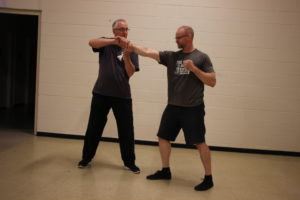
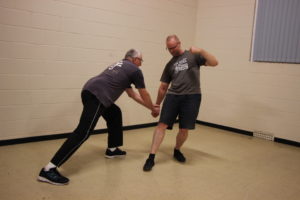



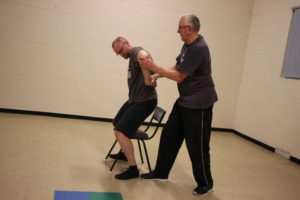
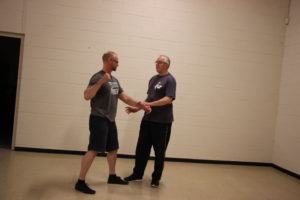
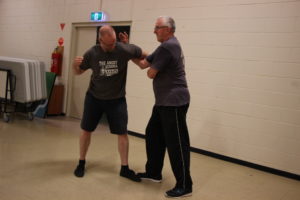
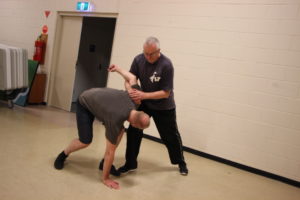
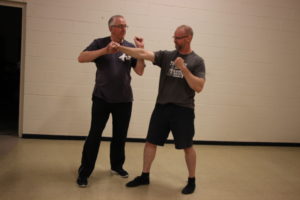



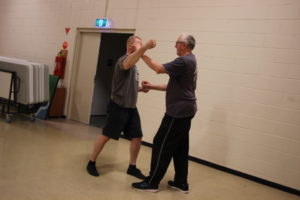

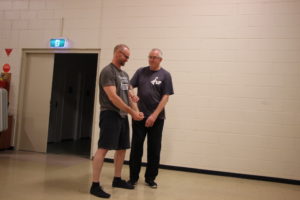


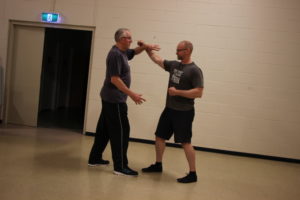
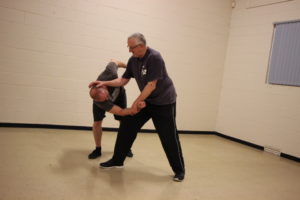
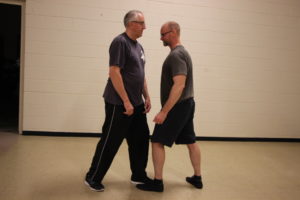

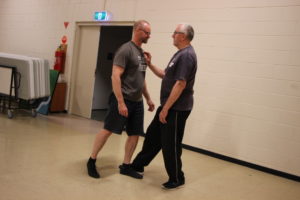

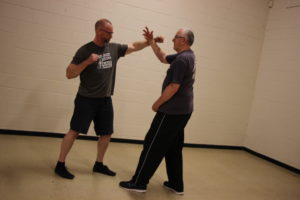

Tom Militello
Excellent sharing of interesting incidents and use of assorted MA techniques.
I studied and later taught in a school that combined CHI DO KWAN ( Korean Karate); combined with techniques from Kodokan Judo; and essential techniques from both Yoshikan and Tomiki Aikido.
While I did not serve as a LEO,….
…. members of my family, circle of friends and fellow followers of MA in our MA school are or were active LEO’s .
That said, I have studied as an adjunct to regular MA studies, effective hands on techniques for Law Enforcement.
I DID NOT have the experience or necessary expertise to claim to be an equal to a sworn LEO. However, my practical knowledge of practiced techniques is expansive. I have also studied the hands on techniques of Sensei Bernie Lau for Law Enforcement and I have been in contact with Sensei Neil Yamamoto, a former student of Sensei Lau.
Ellis Amdur
Tom – Good to hear from you here. You’ve got great experience. What I like so much about Bill Fette’s article is how he has ‘road-tested’ a number of simple techniques. Were we simply to have published the photos and ‘advertised’ them as LEO techniques, it’d be easy for people to pick them apart. But the photos are illustrations in order that people can put image to his words for things that worked for him. Old-school, simple techniques.
Jorge Manuel Cardoso
Very interesting, inspired and with a spoon of good humour.
Richard Bejtlich
This is an outstanding collection of incident reports. Thank you for sharing!